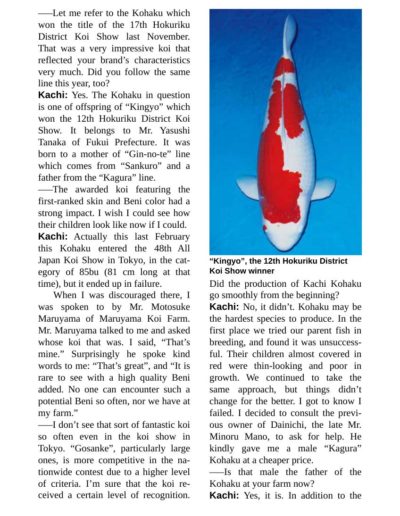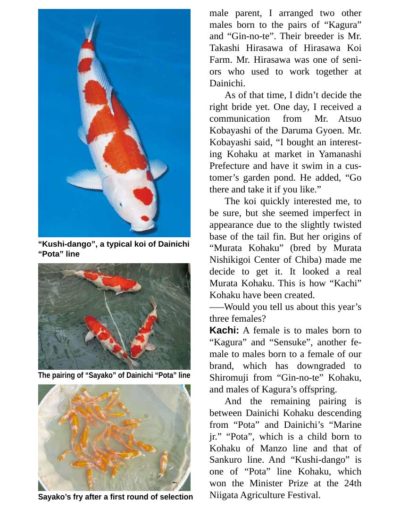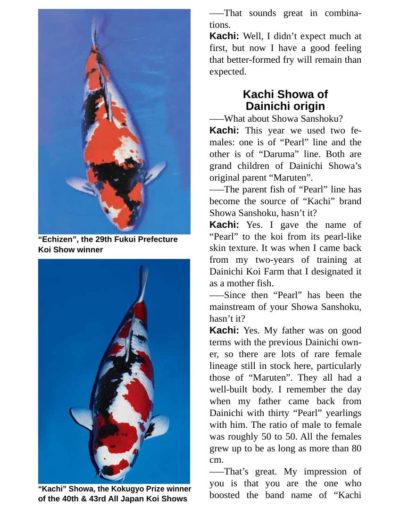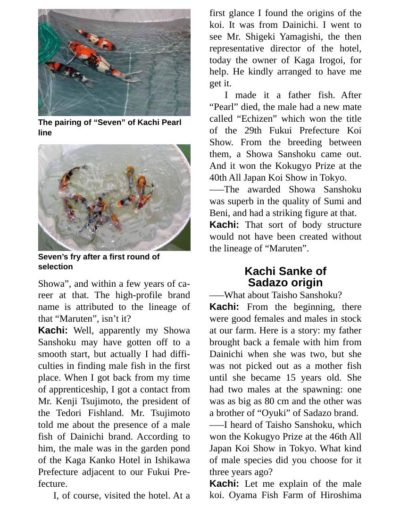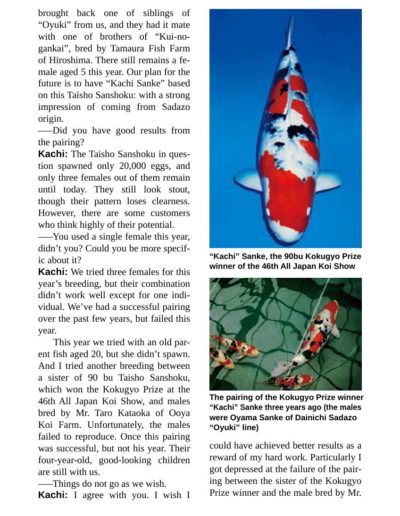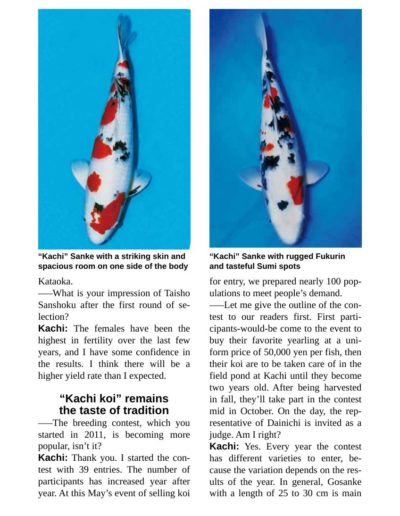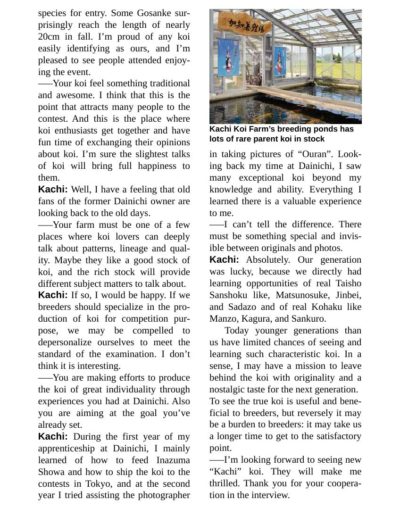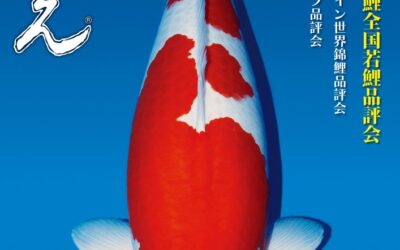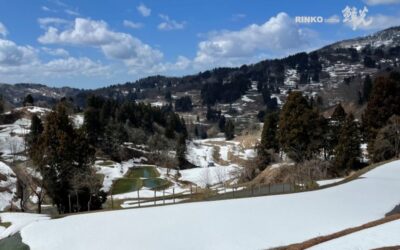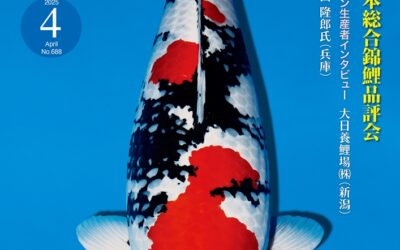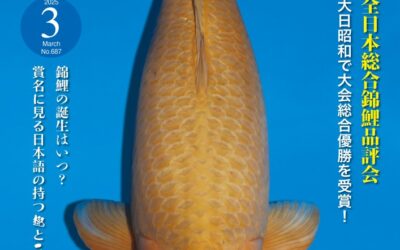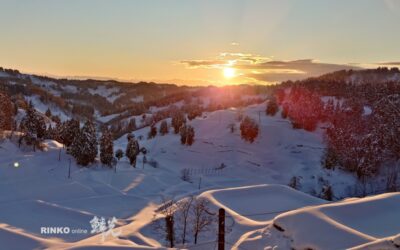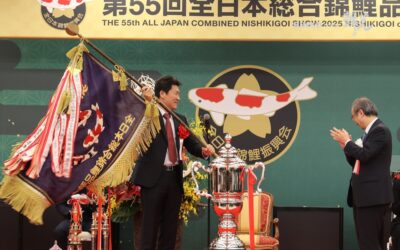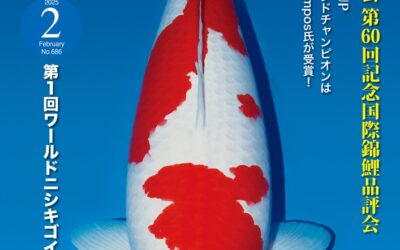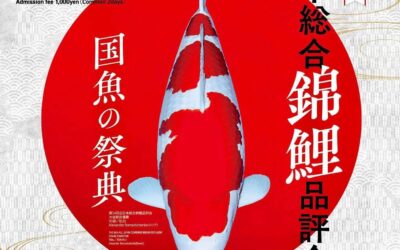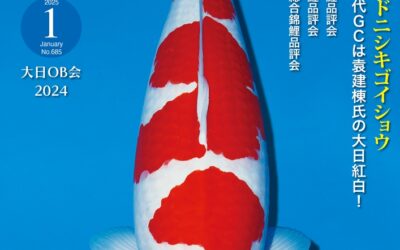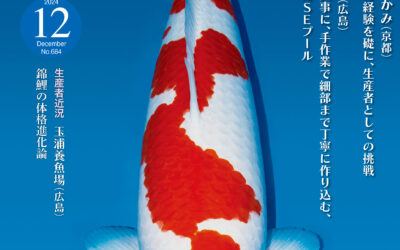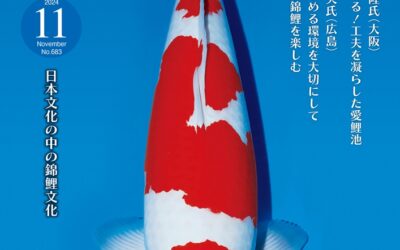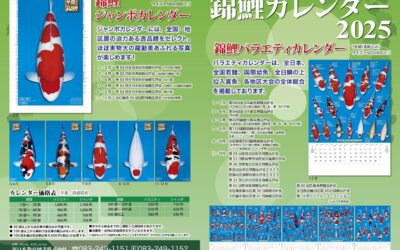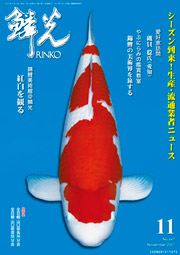Kachi Koi Farm preserves its sustained individuality
** This article is originally from the issue No.688 (2017 October).
“Kachi” Kohaku born to “Kagura” and “Sankuro”
— Would you tell us about this year’s production?
Kachi: June is the month when we usually start. We used 6 females for this year’s breeding including 3 Kohaku, 2 Showa Sanshoku and 1 Taisho Sanshoku.
— Let me refer to the Kohaku which won the title of the 17th Hokuriku District Koi Show last November. That was a very impressive koi that reflected your brand’s characteristics very much. Did you follow the same line this year, too?
Kachi: Yes. The Kohaku in question is one of offspring of “Kingyo” which won the 12th Hokuriku District Koi Show. It belongs to Mr. Yasushi Tanaka of Fukui Prefecture. It was born to a mother of “Gin-no-te” line which comes from “Sankuro” and a father from the “Kagura” line.
— The awarded koi featuring the first-ranked skin and Beni color had a strong impact. I wish I could see how their children look like now if I could.
Kachi: Actually this last February this Kohaku entered the 48th All Japan Koi Show in Tokyo, in the category of 85bu (81 cm long at that time), but it ended up in failure.
When I was discouraged there, I was spoken to by Mr. Motosuke Maruyama of Maruyama Koi Farm. Mr. Maruyama talked to me and asked whose koi that was. I said, “That’s mine.” Surprisingly he spoke kind words to me: “That’s great”, and “It is rare to see with a high quality Beni added. No one can encounter such a potential Beni so often, nor we have at my farm.”
— I don’t see that sort of fantastic koi so often even in the koi show in Tokyo. “Gosanke”, particularly large ones, is more competitive in the nationwide contest due to a higher level of criteria. I’m sure that the koi received a certain level of recognition. Did the production of Kachi Kohaku go smoothly from the beginning?
Kachi: No, it didn’t. Kohaku may be the hardest species to produce. In the first place we tried our parent fish in breeding, and found it was unsuccessful. Their children almost covered in red were thin-looking and poor in growth. We continued to take the same approach, but things didn’t change for the better. I got to know I failed. I decided to consult the previous owner of Dainichi, the late Mr. Minoru Mano, to ask for help. He kindly gave me a male “Kagura” Kohaku at a cheaper price.
— Is that male the father of the Kohaku at your farm now?
Kachi: Yes, it is. In addition to the male parent, I arranged two other males born to the pairs of “Kagura” and “Gin-no-te”. Their breeder is Mr. Takashi Hirasawa of Hirasawa Koi Farm. Mr. Hirasawa was one of seniors who used to work together at Dainichi.
As of that time, I didn’t decide the right bride yet. One day, I received a communication from Mr. Atsuo Kobayashi of the Daruma Gyoen. Mr. Kobayashi said, “I bought an interesting Kohaku at market in Yamanashi Prefecture and have it swim in a customer’s garden pond. He added, “Go there and take it if you like.”
The koi quickly interested me, to be sure, but she seemed imperfect in appearance due to the slightly twisted base of the tail fin. But her origins of “Murata Kohaku” (bred by Murata Nishikigoi Center of Chiba) made me decide to get it. It looked a real Murata Kohaku. This is how “Kachi” Kohaku have been created.
— Would you tell us about this year’s three females?
Kachi: A female is to males born to “Kagura” and “Sensuke”, another female to males born to a female of our brand, which has downgraded to Shiromuji from “Gin-no-te” Kohaku, and males of Kagura’s offspring.
And the remaining pairing is between Dainichi Kohaku descending from “Pota” and Dainichi’s “Marine jr.” “Pota”, which is a child born to Kohaku of Manzo line and that of Sankuro line. And “Kushi-dango” is one of “Pota” line Kohaku, which won the Minister Prize at the 24th Niigata Agriculture Festival.
— That sounds great in combinations.
Kachi: Well, I didn’t expect much at first, but now I have a good feeling that better-formed fry will remain than expected.
Kachi Showa of Dainichi origin
— What about Showa Sanshoku?
Kachi: This year we used two females: one is of “Pearl” line and the other is of “Daruma” line. Both are grand children of Dainichi Showa’s original parent “Maruten”.
— The parent fish of “Pearl” line has become the source of “Kachi” brand Showa Sanshoku, hasn’t it?
Kachi: Yes. I gave the name of “Pearl” to the koi from its pearl-like skin texture. It was when I came back from my two-years of training at Dainichi Koi Farm that I designated it as a mother fish.
— Since then “Pearl” has been the mainstream of your Showa Sanshoku, hasn’t it?
Kachi: Yes. My father was on good terms with the previous Dainichi owner, so there are lots of rare female lineage still in stock here, particularly those of “Maruten”. They all had a well-built body. I remember the day when my father came back from Dainichi with thirty “Pearl” yearlings with him. The ratio of male to female was roughly 50 to 50. All the females grew up to be as long as more than 80 cm.
— That’s great. My impression of you is that you are the one who boosted the band name of “Kachi Showa”, and within a few years of career at that. The high-profile brand name is attributed to the lineage of that “Maruten”, isn’t it?
Kachi: Well, apparently my Showa Sanshoku may have gotten off to a smooth start, but actually I had difficulties in finding male fish in the first place. When I got back from my time of apprenticeship, I got a contact from Mr. Kenji Tsujimoto, the president of the Tedori Fishland. Mr. Tsujimoto told me about the presence of a male fish of Dainichi brand. According to him, the male was in the garden pond of the Kaga Kanko Hotel in Ishikawa Prefecture adjacent to our Fukui Prefecture.
I, of course, visited the hotel. At a first glance I found the origins of the koi. It was from Dainichi. I went to see Mr. Shigeki Yamagishi, the then representative director of the hotel, today the owner of Kaga Irogoi, for help. He kindly arranged to have me get it.
I made it a father fish. After “Pearl” died, the male had a new mate called “Echizen” which won the title of the 29th Fukui Prefecture Koi Show. From the breeding between them, a Showa Sanshoku came out. And it won the Kokugyo Prize at the 40th All Japan Koi Show in Tokyo.
— The awarded Showa Sanshoku was superb in the quality of Sumi and Beni, and had a striking figure at that.
Kachi: That sort of body structure would not have been created without the lineage of “Maruten”.
Kachi Sanke of Sadazo origin
— What about Taisho Sanshoku?
Kachi: From the beginning, there were good females and males in stock at our farm. Here is a story: my father brought back a female with him from Dainichi when she was two, but she was not picked out as a mother fish until she became 15 years old. She had two males at the spawning: one was as big as 80 cm and the other was a brother of “Oyuki” of Sadazo brand.
— I heard of Taisho Sanshoku, which won the Kokugyo Prize at the 46th All Japan Koi Show in Tokyo. What kind of male species did you choose for it three years ago?
Kachi: Let me explain of the male koi. Oyama Fish Farm of Hiroshima brought back one of siblings of “Oyuki” from us, and they had it mate with one of brothers of “Kui-no-gankai”, bred by Tamaura Fish Farm of Hiroshima. There still remains a female aged 5 this year. Our plan for the future is to have “Kachi Sanke” based on this Taisho Sanshoku: with a strong impression of coming from Sadazo origin.
— Did you have good results from the pairing?
Kachi: The Taisho Sanshoku in question spawned only 20,000 eggs, and only three females out of them remain until today. They still look stout, though their pattern loses clearness. However, there are some customers who think highly of their potential.
— You used a single female this year, didn’t you? Could you be more specific about it?
Kachi: We tried three females for this year’s breeding, but their combination didn’t work well except for one individual. We’ve had a successful pairing over the past few years, but failed this year.
This year we tried with an old parent fish aged 20, but she didn’t spawn. And I tried another breeding between a sister of 90 bu Taisho Sanshoku, which won the Kokugyo Prize at the 46th All Japan Koi Show, and males bred by Mr. Taro Kataoka of Ooya Koi Farm. Unfortunately, the males failed to reproduce. Once this pairing was successful, but not his year. Their four-year-old, good-looking children are still with us.
— Things do not go as we wish.
Kachi: I agree with you. I wish I could have achieved better results as a reward of my hard work. Particularly I got depressed at the failure of the pairing between the sister of the Kokugyo Prize winner and the male bred by Mr. Kataoka.
— What is your impression of Taisho Sanshoku after the first round of selection?
Kachi: The females have been the highest in fertility over the last few years, and I have some confidence in the results. I think there will be a higher yield rate than I expected.
“Kachi koi” remains the taste of tradition
— The breeding contest, which you started in 2011, is becoming more popular, isn’t it?
Kachi: Thank you. I started the contest with 39 entries. The number of participants has increased year after year. At this May’s event of selling koi for entry, we prepared nearly 100 populations to meet people’s demand.
— Let me give the outline of the contest to our readers first. First participants-would-be come to the event to buy their favorite yearling at a uniform price of 50,000 yen per fish, then their koi are to be taken care of in the field pond at Kachi until they become two years old. After being harvested in fall, they’ll take part in the contest mid in October. On the day, the representative of Dainichi is invited as a judge. Am I right?
Kachi: Yes. Every year the contest has different varieties to enter, because the variation depends on the results of the year. In general, Gosanke with a length of 25 to 30 cm is main species for entry. Some Gosanke surprisingly reach the length of nearly 20cm in fall. I’m proud of any koi easily identifying as ours, and I’m pleased to see people attended enjoying the event.
— Your koi feel something traditional and awesome. I think that this is the point that attracts many people to the contest. And this is the place where koi enthusiasts get together and have fun time of exchanging their opinions about koi. I’m sure the slightest talks of koi will bring full happiness to them.
Kachi: Well, I have a feeling that old fans of the former Dainichi owner are looking back to the old days.
— Your farm must be one of a few places where koi lovers can deeply talk about patterns, lineage and quality. Maybe they like a good stock of koi, and the rich stock will provide different subject matters to talk about.
Kachi: If so, I would be happy. If we breeders should specialize in the production of koi for competition purpose, we may be compelled to depersonalize ourselves to meet the standard of the examination. I don’t think it is interesting.
— You are making efforts to produce the koi of great individuality through experiences you had at Dainichi. Also you are aiming at the goal you’ve already set.
Kachi: During the first year of my apprenticeship at Dainichi, I mainly learned of how to feed Inazuma Showa and how to ship the koi to the contests in Tokyo, and at the second year I tried assisting the photographer in taking pictures of “Ouran”. Looking back my time at Dainichi, I saw many exceptional koi beyond my knowledge and ability. Everything I learned there is a valuable experience to me.
— I can’t tell the difference. There must be something special and invisible between originals and photos.
Kachi: Absolutely. Our generation was lucky, because we directly had learning opportunities of real Taisho Sanshoku like, Matsunosuke, Jinbei, and Sadazo and of real Kohaku like Manzo, Kagura, and Sankuro.
Today younger generations than us have limited chances of seeing and learning such characteristic koi. In a sense, I may have a mission to leave behind the koi with originality and a nostalgic taste for the next generation.
To see the true koi is useful and beneficial to breeders, but reversely it may be a burden to breeders: it may take us a longer time to get to the satisfactory point.
— I’m looking forward to seeing new “Kachi” koi. They will make me thrilled. Thank you for your cooperation in the interview.
Join as a free RINKO Member for increased access and subscribe as a paid member for full access to our content.
Japanese RINKO 2025 May issue adverts
by RINKO online | Apr 28, 2025
Japanese RINKO 2025 May issue adverts 鱗光 2025年5月号広告一覧
Magazine Issue Update
by RINKO online | Mar 27, 2025
[ Magazine Issue Update ] https://rinkoonline.com/magazine-issues/ ...
Japanese RINKO 2025 April issue adverts
by RINKO online | Mar 18, 2025
Japanese RINKO 2025 April issue adverts 鱗光2025年4月号掲載広告
Japanese RINKO 2025 March issue adverts
by RINKO online | Feb 20, 2025
Japanese RINKO 2025 March issue adverts 鱗光2025年3月号掲載広告
Magazine Issue Updates
by RINKO online | Feb 18, 2025
[ Magazine Issue Update ] https://rinkoonline.com/magazine-issues/ 1st World...
55th All Japan Koi Show Recap
by RINKO online | Jan 31, 2025
55th All Japan Koi Show RecapThe 55th All Japan Koi Show was held at Tokyo...
Japanese RINKO 2025 February issue adverts
by RINKO online | Jan 23, 2025
Japanese RINKO 2025 February issue adverts 鱗光 2025年2月号掲載広告 ...
55th All Japan Koi Show 2025
by RINKO online | Jan 18, 2025
The Biggest Event of the Year! The 55th Alll Japan Koi Show DATE: Jan 26-27th...
Japanese RINKO 2025 January issue adverts
by RINKO online | Dec 20, 2024
Japanese RINKO 2025 January issue adverts 鱗光 2025年1月号広告一覧 Front cover features...
Japanese RINKO 2024 December issue adverts
by RINKO online | Nov 21, 2024
Japanese RINKO 2024 December issue adverts 鱗光 2024年12月号掲載広告 ...
Japanese RINKO 2024 November issue adverts
by RINKO online | Oct 22, 2024
Japanese RINKO 2024 November issue adverts 鱗光 2024年11月号掲載広告
Nishikigoi Calendar 2025
by RINKO online | Sep 30, 2024
Nishikigoi Calendar 2025 *Jumbo Calendar [Jan/Feb] Grand Champion of the...
RINKO Koi Magazine is NOW available online!
Blog Categories
Reminder: You must login or register for website to vote in our polls.


